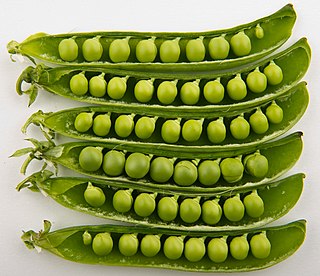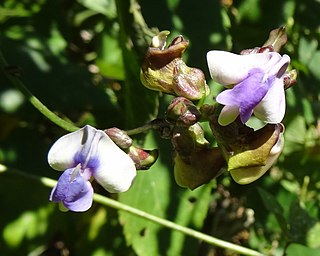
Pea is a pulse, vegetable or fodder crop, but the word often refers to the seed or sometimes the pod of this flowering plant species, formerly 'Pisum sativum', now renamed Lathyrus oleraceus based on the work of Schaefer et al. (2012). Each pod contains several seeds (peas), which can have green or yellow cotyledons when mature. Botanically, pea pods are fruit, since they contain seeds and develop from the ovary of a (pea) flower. The name is also used to describe other edible seeds from the Fabaceae such as the pigeon pea, the cowpea, the seeds from several species of Lathyrus and is used as a compound form for example Sturt's desert pea.

Mesquite is a common name for several plants in the genus Prosopis, which contains over 40 species of small leguminous trees. They are native to dry areas in the Americas. They have extremely long roots to seek water from very far under ground. As a legume, mesquites are one of the few sources of fixed nitrogen in the desert habitat. The trees bloom from spring to summer. They often produce fruits known as "pods". Prosopis spp. are able to grow up to 8 metres (26 ft) tall, depending on site and climate. They are deciduous and depending on location and rainfall have either deep or shallow roots. Prosopis is considered long-lived because of the low mortality rate after the dicotyledonous stage and juveniles are also able to survive in conditions with low light and drought. The Cahuilla indigenous people of western North America were known to eat the seeds of mesquite.

A legume is a plant in the family Fabaceae, or the fruit or seed of such a plant. When used as a dry grain, the seed is also called a pulse. Legumes are grown agriculturally, primarily for human consumption, for livestock forage and silage, and as soil-enhancing green manure. Well-known legumes include beans, soybeans, chickpeas, peanuts, lentils, lupins, grass peas, mesquite, carob, tamarind, alfalfa, and clover. Legumes produce a botanically unique type of fruit – a simple dry fruit that develops from a simple carpel and usually dehisces on two sides.

Vigna is a genus of plants in the legume family, Fabaceae, with a pantropical distribution. It includes some well-known cultivated species, including many types of beans. Some are former members of the genus Phaseolus. According to Hortus Third, Vigna differs from Phaseolus in biochemistry and pollen structure, and in details of the style and stipules.

Vigna subterranea is a member of the family Fabaceae. Its name is derived from the Bambara tribe. The plant originated in West Africa. As a food and source of income, the Bambara groundnut is considered to be the third most important leguminous crop in those African countries where it is grown, after peanut and cowpea. The crop is mainly cultivated, sold and processed by women, and is, thus, particularly valuable for female subsistence farmers.

The winged bean, also known as cigarillas, goa bean, four-angled bean, four-cornered bean, manila bean, princess bean, star bean, kamrangi bean, pea, dragon bean, is a tropical herbaceous legume plant.

Lablab purpureus is a species of bean in the family Fabaceae. It is native to sub-Saharan Africa and India and it is cultivated throughout the tropics for food. English language common names include hyacinth bean, lablab-beanbonavist bean/pea, dolichos bean, seim or sem bean, lablab bean, Egyptian kidney bean, Indian bean, bataw and Australian pea. Lablab is a monotypic genus.

Parkinsonia aculeata is a species of perennial flowering tree in the pea family, Fabaceae. Common names include palo verde, Mexican palo verde, Parkinsonia, Jerusalem thorn, jelly bean tree, palo de rayo, and retama.

Sesbania drummondii, known as poisonbean, rattlebox and rattlebush, is a medium-sized perennial shrub in the legume family Fabaceae. It is native to the southeastern United States, from Texas east to Florida.

Lathyrus tuberosus is a small, climbing perennial plant, native in moist temperate parts of Europe and Western Asia. The plant is a trailer or weak climber, supported by tendrils, growing to 1.2 m tall. The leaves are pinnate, with two leaflets and a branched twining tendril at the apex of the petiole. Its flowers are hermaphroditic, pollinated by bees. The plants can also spread vegetatively from the root system.

Acacia saligna, commonly known by various names including coojong, golden wreath wattle, orange wattle, blue-leafed wattle, Western Australian golden wattle, and, in Africa, Port Jackson willow, is a small tree in the family Fabaceae. Native to Australia, it is widely distributed throughout the south west corner of Western Australia, extending north as far as the Murchison River, and east to Israelite Bay. The Noongar peoples know the tree as Cujong.

Melilotus officinalis, known as sweet yellow clover, yellow melilot, ribbed melilot and common melilot, is a species of legume native to Eurasia and introduced in North America, Africa, and Australia.

Melilotus albus, known as honey clover, white melilot (UK), Bokhara clover (Australia), white sweetclover (US), and sweet clover, is a nitrogen-fixing legume in the family Fabaceae. Melilotus albus is considered a valuable honey plant and source of nectar and is often grown for forage. Its characteristic sweet odor, intensified by drying, is derived from coumarin.

Tylosema esculentum, with common names gemsbok bean and marama bean or morama bean, is a long-lived perennial legume native to arid areas of southern Africa. Stems grow at least 3 metres (9.8 ft), in a prostrate or trailing form, with forked tendrils that facilitate climbing. A raceme up to 25 millimetres (1 in) long, containing many yellow-orange flowers, ultimately produces an ovate to circular pod, with large brownish-black seeds.

Kennedia is a genus of thirteen species of flowering plants in the pea family Fabaceae and is endemic to Australia. Plants in this genus are prostrate or climbing perennials with trifoliate leaves and large, showy, pea-like flowers. There are species in all Australian states.

Dalea searlsiae, commonly known as Searls' prairie clover, is a perennial legume species belonging to the Dalea genus. The species is found through arid regions of the southwestern United States and can survive in low moisture conditions. The species forms symbiotic relationships with nitrogen-fixing bacteria that can improve soil nutrient levels. Its large inflorescence attracts many species of pollinators, and it lacks toxins found in similar legume species. As a result, the species has been considered for use in rangeland restoration and revegetation projects.

Caragana halodendron is a species of flowering plant in the pea family (Fabaceae). It is known by several common names, including common salt tree and Russian salt tree. It is native to Russia and southern Asia, but it can be found on other continents where it is an introduced species, and one that is often a noxious weed. This is a deciduous spiny shrub sprawling to a few meters in maximum width and up to three meters tall. Stems branch from the base and bear clusters of about four leaflets on sharp spurs. The ends of branches narrow to spines. Flowers also appear at the ends of spurs in clusters of two to four pink pealike blossoms each one to two centimeters wide. The fruit is a black woody inflated pod about 2 centimeters long containing legume seeds. The plant has a deep and wide root system, with the lateral roots sending up new shoots. In this manner the plant forms extensive thickets. When introduced to an area of suitable climate, such as California where it is a known weed, it can invade cultivated land and spread relatively quickly. It is tolerant of saline soils.

Dolichos is a genus of flowering plants in the legume family, Fabaceae, and the subfamily Faboideae. It is distributed in Africa and Asia.

Aeschynomene virginica is a rare species of flowering plant in the legume family known by the common names Virginia jointvetch and sensitive jointvetch. It is native to a small section of the East Coast of the United States, where it has a fluctuating annual global population scattered in about 20 mostly small occurrences. Counts and estimates revealed two populations in New Jersey including several thousand individuals, one population of a few hundred plants in Maryland, several variable and unstable populations in ditches in North Carolina, and several populations including about 5000 individuals in Virginia. Habitat alteration has reduced the number of sites where the plant can grow. The plant became a federally listed threatened species of the United States in 1992.

Trigonella suavissima is a herbaceous plant that is endemic to Australia. It is a member of the genus Trigonella and the family Fabaceae. Common names include Cooper clover, Menindee clover, calomba, Darling trigonella, sweet fenugreek, channel clover, sweet-scented clover and Australian shamrock.





















